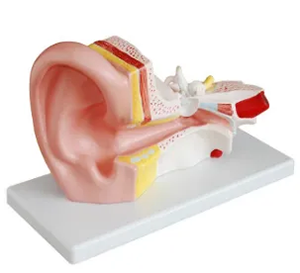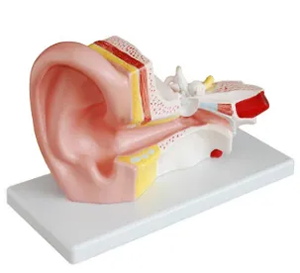Are anatomical models of the middle ear just for anatomy classes? This question actually touches on the far-reaching significance of middle ear anatomical model in medical education, clinical training and scientific research fields. Here's a closer look at the issue:
First of all, it does play an important role in the anatomy class. It provides students with an intuitive, three-dimensional learning platform that enables them to clearly see the various structures of the middle ear, including the osculum chain, tympanic membrane, tympanic chamber, etc. This intuitive learning method helps deepen students' understanding and memory of middle ear anatomy and lays a solid foundation for subsequent clinical study and practice.

However, the value goes far beyond that. It is not only a teaching aid in the anatomy classroom, but also an important tool in medical education and clinical training. In medical education, it can be used to simulate surgical operations to help students familiarize themselves with surgical procedures and techniques. Through repeated practice, students can gradually master the basic skills of middle ear surgery and improve the safety and success rate of surgery. In addition, the model can also be used to simulate pathological conditions to help students understand the pathogenesis and treatment of diseases such as otitis media and tympanic membrane perforation.
In clinical training, it also plays an irreplaceable role. For doctors entering the clinic, facing the real middle ear structure can be unfamiliar and stressful. The middle ear anatomy model provides a safe and controlled practice environment in which they can gradually become familiar with and master middle ear surgery techniques during simulated surgical procedures. This simulation training not only helps to improve the surgical skills of doctors, but also reduces the surgical risk and improves the therapeutic effect of patients.
In addition, it has important application value in the field of scientific research. Researchers can use the model to carry out mechanical analysis of the middle ear structure, acoustic characteristics research, etc., in order to deeply understand the physiological function and pathological mechanism of the middle ear. These research results can not only provide scientific basis for the diagnosis and treatment of diseases such as otitis media and hearing impairment, but also provide important reference for the research and development of middle ear surgical instruments and rehabilitation instruments.
To sum up, anatomy is not only a decoration in the classroom, it has important application value in the field of medical education, clinical training and scientific research. Therefore, we should pay more attention to the development and application of middle ear anatomical model, and provide more support and help for medical education and clinical training.

